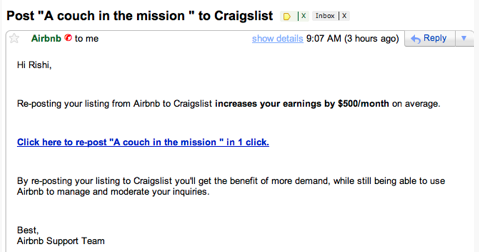Famous Examples of Growth Hacking
Airbnb
Airbnb has always worked hard to distinguish themselves from Craigslist however when starting out, Craigslist had something they wanted —a massive user base.
In order to tap into this their huge market share, Airbnb offered users who listed properties on Airbnb the opportunity to post them to Craigslist as well—despite the fact that there was no sanctioned way to do so.
The benefits of the Airbnb/Craigslist integration were numerous. Not only were the volume of potential users accessible via Craigslist, but the fact that Airbnb listings were far superior to the other properties available—more personal, with better descriptions and nicer photos—made them more appealing to Craigslist users looking for vacation properties

As well as this, Airbnb would send thousands of the below emails to the owners that were listing their properties on Craigslist.
Though this hack definitely constitutes spam it certainly helped Airbnb to grow their listings quickly and at almost no cost.
StatusPage
“We owe 25% of our growth to one line of code”.

At Y Combinator, back in 2013, Status page had this conversation with their designated partner, Kevin Hale:
Kevin Hale: Guys, why the hell are you offering the people the chance to take your “powered by” branding off their status page?
StatusPage: Well, once people are paying for the service, we don’t think our branding should be on the page.
KH: Don’t do it.
SP: But we think it will piss people off.
KH: Don’t do it.
SP: Even for our top tier?
KH: DON’T DO IT.
SP: But…
KH: Look, if Desk.com can get away with it, so can you guys.
Kevin was 100% right.
This conversation totally changed the trajectory of our business. It keyed our growth from $5k MRR to $25k MRR and provided a scalable acquisition to grow far, far beyond that.
Some of the customers that Statuspage has attracted through this link are huge accounts like Cisco, Adobe, Contactually, BlazeMeter, Barracuda Networks, Take-Two Interactive, and Chartio.
Hotmail
The email startup executed one of of the web’s earliest growth hacks (though the term wouldn’t be coined for another fourteen years).
Rather than blowing its marketing budget on advertising, groundbreaking browser-based email service Hotmail elected to leverage a free resource it already had— existing users.
Hotmail already had about 20,000 users one month after launching in 1996 and it opted to market its service directly to the friends, family and colleagues of those users by employing a simple strategy: It added a tagline, “Get Your Free Email at Hotmail,” at the end of each existing user’s outgoing mail.

When a Hotmail user sent out an email on his or her account, the recipient could click on the tagline link, which would direct them to a page where they could set up their own account. As a result, the company user base not only skyrocketed to 1 million users within 6 months.
Dropbox
There are a lot of services out there that use incentivized invites, but Dropbox has one of the best implementations I’ve seen. Whenever you login to Dropbox’s web interface, there is a constant reminder to invite more friends. Sitting in the top toolbar you can’t help but notice the little giftbox icon with the enticing label “Get free space!” rather than the more boring”Invite friends”. After clicking the giftbox Dropbox informs you that can get 500MB of space for each friend you invite. 500MB is a pretty sizeable amount, especially when you consider it is 10% of what you start off with in the free version of Dropbox. There are two important traits that an incentive should have and Dropbox nailed both of them. First, an incentive needs to be very appealing to the user. Badges, unlocking features, etc., only appeal to a subset of users. A good incentive is something that all users will find appealing. The second trait is that the user should start seeing the benefit after the first few invites.
Before you put thousands of dollars into Facebook or Google ads first see if there is a way
to implement a growth hack. Facebook encourages people to find their friends via email. Amazon sends daily emails related to your recent searches. Some eCommerce websites email you with a 10% off coupon if you haven’t ordered from them in a while. How do you help users on their initial first steps with your product? What do you do to help them keep coming back?
Need some ideas? Chat to us today!
Are you ready to grow your business?
We write about a variety of topics in the digital industry.


